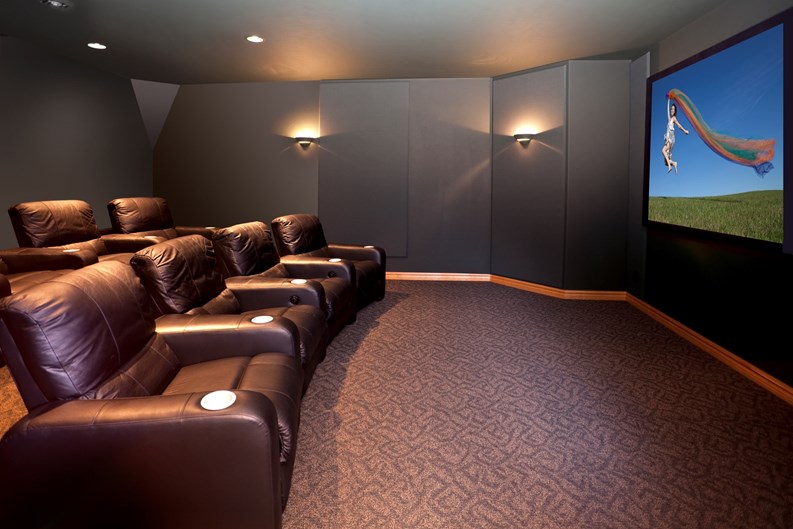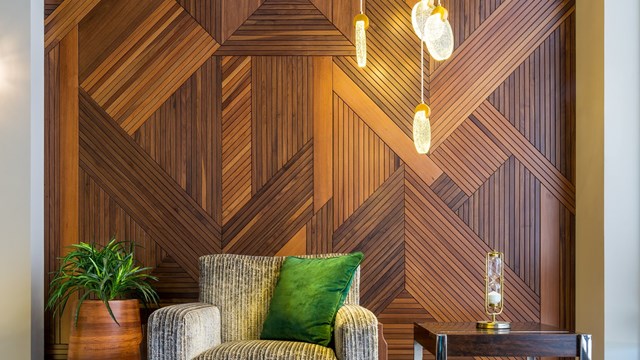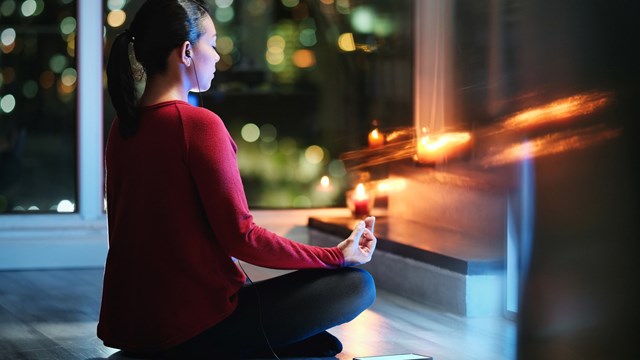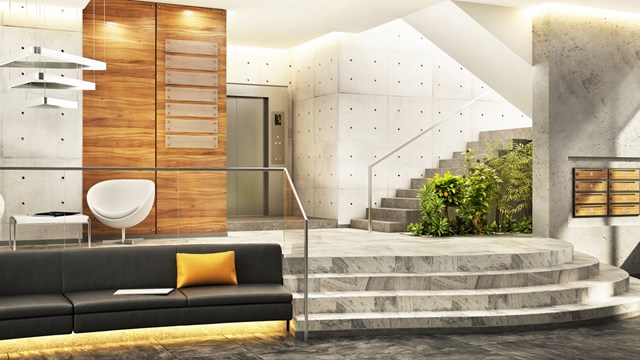Just as the ways in which we socialize have changed in recent years, so too have the spaces in which that socializing has traditionally been done. Common spaces and amenities in multifamily buildings and condo associations have evolved to support the needs of modern condo residents and shareholders, with added emphasis on flexibility, resources and design.
“With more people working from home today, there is a greater focus on amenity spaces,” says Susan Lauren, a licensed interior designer and principal with Lauren Interior Design, LLC, based in Manhattan, who services clients in New York City and New Jersey. “They are more sought after and more frequently used. In today’s market, amenity spaces need to be innovative, upscale and inviting to give their home communities a competitive edge. They need to incorporate state-of-the-art technology and WiFi.”
That means taking a close look at the specific needs of the residents of a particular building or community. What is appealing to a building filled with young professionals or families may not be exactly the same for a building dominated by retirees, or a smaller community intent on keeping costs low.
Doug Weinstein, vice president of operations and compliance for AKAM Associates, Inc., a property management company with offices around the country, sees this evolution in the buildings and associations his firm manages in Florida. “Common area spaces are evolving due to a changeover in residents,” he says. “Condos used to be primarily seniors, but now it’s changing to a younger clientele.”
Building managers and boards are working hard to stay ahead of the game or compete with new construction rising up in the blocks and neighborhoods around them. And designer Jonathan Baron, ASID, and president of Baron Design, Inc. in New York City, who also has many clients in the tri-state area, says, “I’m revamping older places that are trying to compete with new buildings.”
New Looks for a New Audience
Today’s common spaces blend a bit of the old with a lot of the new. “While amenity spaces used to be limited to community rooms for meetings and parties and maybe a gym or roof deck, today they run the gamut from business centers, lounges with espresso machines and wet bars, libraries, theaters and billiard or game rooms to wine cellars and swimming pools in new construction,” says Lauren.
Multi-function rooms are also much sought-after, especially if buildings have limited space for social areas, says Lauren. “We recently completed an upscale, multi-use lounge space with audio/visual and WiFi capabilities in a luxury condo on the Upper West Side,” she says. “It is furnished with a large conference table for meetings, library and tables for quiet work, and also provides lounge furniture, full wet bar, and an ADA-compliant restroom to accommodate fund-raising events and parties.”
Among the most popular spaces that Weinstein has seen are card rooms, social rooms with or without kitchens and fitness centers. “A lot of modern buildings over the last five to seven years usually have built in a media or theater room at the time of construction,” he says. “Some buildings might also have wine rooms.” He also is starting to see dog grooming rooms, giving people a place to connect with their four-legged companions.
In Florida, co-op and condo communities, as more unit owners are turning in their snowbird cards and becoming full-time residents, Weinstein says buildings are making changes to accommodate families—including grandparents who may be welcoming their children and grandchildren over holidays or school breaks. These buildings, he says, are converting card rooms into rec areas with a broader appeal to both younger and older residents, including play rooms with video games, conversation spaces and pool tables.
In older buildings, Baron says he's noticed a number of communities move to transform lobbies into new, more dynamic spaces. This includes “cafe-type spaces that don't serve food, but where people can come down from their apartments, bring their own coffee, plug in their laptops and work,” he says. Especially as more people work independently and from home, café spaces like these give residents a chance to change their environment and sit or network with others in their building, like a non-office office space.
Aside from the work angle, lounge-style lobbies also give residents a chance to meet up with friends or spend some time to themselves without being in the center of the action in a plush lounge chair stationed between the building’s entrance and elevator.
Baron says these new types of common spaces are being built adjacent to lobby areas, which, in turn, is allowing buildings to make their lobbies smaller.
Everyone agrees that the one true must-have for a co-op or condo common area is the ability to accommodate laptops and mobile devices. “The one thing you have to have is WiFi capability, without a doubt,” says Weinstein. “When we build or re-do rooms now, we’re also making sure that all electrical outlets also have USB charging capabilities.”
Bringing People Together
In addition to hardware and built-in amenities, social programming is another way buildings and associations are enriching their common area package for residents. Programming can include everything from guest lectures to cooking classes, depending on the environment available and the interests of the prospective audience.
“You have to structure your activities to the age group in your building,” says Weinstein. “A lot of times we’ll have a resident committee plan the events. Buildings also will put out surveys to ask residents directly what they'd like to see. We’ve had lectures on finance; other times, we’ve had people come in to give talks in conjunction with a film screening.”
Off-site 'field trips' are also no longer just the purview of retirement or active adult communities—they're something more residents, young and old, are enjoying as an added perk. Trips can include anything and everything, from a sponsored bowling trip to a group dinner at a new restaurant, or a heading out for a sponsored bowling trip or night out at a new restaurant. At the heart of it, these trips serve the same purpose as common spaces themselves do—to bring people together.
The Heart of Community
Common spaces can play a large role in attracting new buyers and shareholders. Older buildings are asking “What can we do to modernize and attract young people to our buildings?” says Baron. “As demographics change, you’re seeing young families but they don’t want to pay premium prices for a new building.” This means older buildings are looking at ways to compete and bring those families into the community. Often, that means updating and maximizing the common space they have.
“Every social area should have a 'wow' factor,” says Lauren. “Amenity spaces can be a very strong selling point for the building if they are designed to be inviting and visually exciting. Each space is different, and each building has different requirements and preferences—in terms of function and features, as well as aesthetics.”
Often, finding the right fit for that particular building means asking questions, especially of the people for whom the space is being designed.“Prior to beginning the design process, I work closely with boards to establish the ‘must-have’ features,” says Lauren. “I often prepare questionnaires so each resident can provide input before any decisions are made.”
Filled Rooms, Not Empty Ones
Sometimes, despite the best of intentions, a common area such as a lounge or kids area may not get much use. It could simply be that the demographics of the building has changed or it could have something to do with outdated equipment, in the case of a gym perhaps, or a design that has not kept up with the times.
Weinstein says that he and his team track the usage of these areas as part of their day-to-day operations as managers. “We walk the properties every day and check these rooms,” he says. That includes outdoor areas like cabanas, patios, swimming pools, and barbecues.
“If a space isn’t getting much traffic, I would first question the function of the space,” says Lauren. “Perhaps it can be transformed into a multi-function space or should be replaced with a more sought-after amenity. Once function is addressed, the aesthetics should be redesigned to be more appealing. Spaces should be stylish and chic, as well as warm and inviting. The aesthetics often depend on the use of the space—it may be colorful and lively or serene and uncluttered. The style of the amenities should also reflect the overall feeling, aesthetics and location of the building itself.”
Sometimes that re-evaluation of space usage leads to a revamp that may lack the excitement of a new media room but more fully meets the needs of residents. Both Baron and Weinstein say they are seeing more requests for storage space. It may not be a glamorous addition, but it can make a big difference for unit owners and shareholders. In particular, storage in mailbox areas or in buildings without doorman are a priority.
“Package storage is the number one issue,” says Baron. “Just look at the way we shop these days, especially for busy New Yorkers. In buildings that are unmanned, those packages are just left outside, not at the doors of individual apartments. We are repurposing a lot of lobby spaces for package storage.”
Weinstein says that storage issues are arising as more people are moving into a full-time residency, trying to fit the contents of what was once two houses or condos into one.
Adding to the Bottom Line
In some cases, common areas can become revenue generators for buildings and boards. Fitness centers can help spur income through memberships, although “for the most part, we see the memberships included as part of their residency,” says Weinstein.
Meeting or community rooms also can help bring in modest income through rentals for parties or gatherings. Some buildings also are offering wine rooms, where unit owners and shareholders can buy a locker in a climate-controlled space and store their stock of wine, whiskey or other beverages.
For communities offering beachfront access, “dockage is one of the things that buildings are looking at as revenue enhancers,” says Weinstein.
Ultimately, the role of a common space will be dictated by the needs, tastes and expectations of the individuals and families who use it. Nearly every building, no matter its size, has its own personality, one generated by its residents and one that will be reflected in the screening room, café, package room, gym or beachfront barbecue designed to make residents feel right at home.
Liz Lent is a freelance writer and a frequent contributor to The New Jersey Cooperator.










Leave a Comment